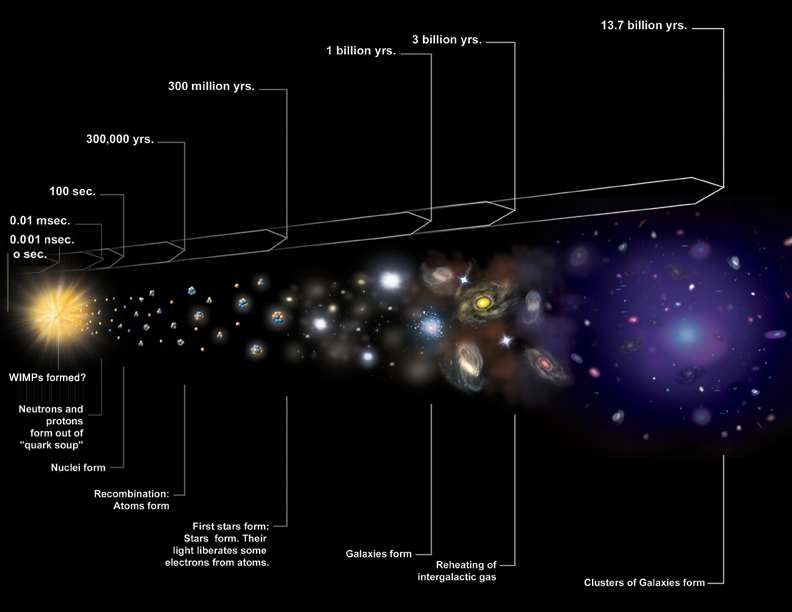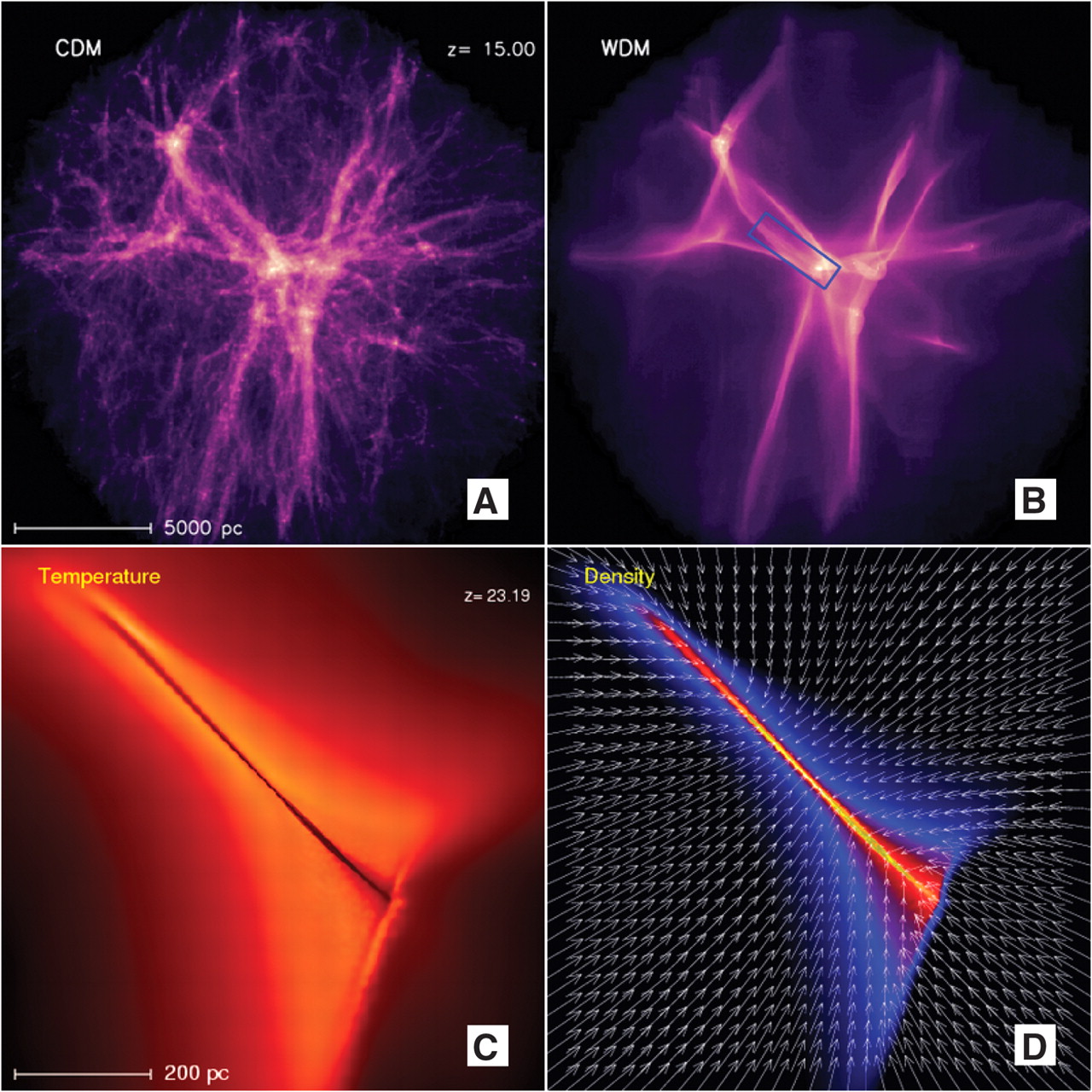What is the temperature of dark matter?
The fact never went hand in hand with a miracle. Truth despises the help of miracles. The fact coincides with any other fact in the universe, and that is how one can find out whether it is a fact or not. A lie does not coincide with anything other than another lie.
- Robert Green Ingersoll
One of the most amazing facts about the Universe is that it is knowable! A few basic laws, properties, and particles, as far as we know, can lead us from a hot, dense and almost uniform Universe to a complex system of billions of stars in the billions of galaxies we observe.

One of the most surprising, but also the most reliable results of the study of the Universe is that dark matter, one of the forms of matter that does not interact with light, atoms or with itself, except gravitational interaction, not only exists, but also prevails over the number of atoms five times!
An enormous amount of evidence leads to this conclusion, two of which are the best fluctuations in relic radiation.
')

and the distribution of galaxies — known as large-scale structures — across the universe.

What we would like to do next is to figure out how to create and / or detect dark matter in order to understand what it is.
Unfortunately, since it does not interact with ordinary matter, except through gravity, and gravity is weaker every 10 30 times than other known interactions, we have so far failed to do this. But one of the questions we can ask and answer through observations is what is the kinetic energy of dark matter in relation to its mass.

The fluctuations of the CMB are completely independent of this. Dark matter could move at ultrarelativistic speeds, or practically not move at all, and these fluctuations would not change at all.
But many things are sensitive to the speed of dark matter. As an analogy, think of it as molecules inside a ball.

If the molecules move quickly, it means high temperature, and the ball is subjected to pressure from the inside, as a result of which it becomes large and the gas in the ball becomes rarefied.
On the other hand, if the molecules move slowly, this corresponds to a low temperature, the pressure of the ball from the inside is small, and it becomes small, and the gas inside it is dense.
But this analogy cannot be applied to dark matter completely. Ordinary molecules collide with each other and with the surface of the ball. Dark matter simply flies at the speed it has in an expanding universe. It can either move slowly enough to facilitate gravitational collapse of objects (and the formation of stars, galaxies, clusters, etc.), or move quickly, making it difficult to form them.
Look into the past of the universe to clarify this issue.

We will see many structures that impose a limit on temperature, or the speed of dark matter. In the universe with an age of several hundred million years, we will discover not only galaxies or quasars, although their presence is very important.

We will find, on a smaller scale, collapsed particles of primordial hydrogen, very dense and cold. Due to the depth and small width of the lines on the graphs - the absorption lines of cold pieces of hydrogen in the early Universe - we can pretty well limit the speed of motion of dark matter.

So we can reject the idea of hot dark matter, most of which is some kind of ordinary relativistic neutrino of small mass. But we can simulate different temperatures of dark matter - hot, cold, or something average, and look at the predictions we get.

Top down - models of cold, warm and hot dark matter.
This is where the fun begins. Cold and warm TM give results that generally coincide with observations of the structures of small and large scales. On scales of hundreds of thousands of light years and above, these two types of TM form almost indistinguishable structures. But on a smaller scale, not exceeding a single large galaxy, there are very clear differences.

For simulation, you can study individual galaxies and recreate the distribution of dark matter in them. The predictions of the theory of cold TM coincide with the four upper lines that are difficult to reconcile with observations. The isothermal model (bottom line) always works better, but for it there are no suitable candidates among the particles (and for a cold TM there are WIMPs, axions, and a bunch of other candidates).
But astronomers have long believed that a warm TM would be better. Physicists preferred the cold TM, since it would be easier to detect it - this is where the efforts of most projects, including CDMS, XENON, Edelweiss and BAC, are concentrated.

But there has long been another mystery. On the scales of individual galaxies such as our Milky Way, the cold TM predicts a large number of lumpy satellite galaxies. And although in our local group there are many of them, but still not as many as necessary.
Carlos Frenk from the University of Durham — and the letter F in the NFW profile was taken from his last name — for the last few years he has been working on a set of very sensitive TM simulations and structure formation, with the result that he obtained very important results.

Warm TM works! The dwarf galaxies around the Milky Way are not as dense and not as many as the theory of cold TM required, but the results of warm TM simulation coincide with the observations!
This is especially surprising since we can compare the results of the effects of cold and warm TM on large scales, where our observations have long been very accurate.

They are the same! On a large scale, cold and warm TM give identical results for clusters. This is wonderful, for it is here that our theory is the best fit to the observations!
And on a smaller scale?

Warm TM cope better. But if warm TM is an answer to our astronomical riddle, then what will this mean for physics?
This means that we will not find it where we are looking for now. Probably, these are sterile neutrinos; The fourth kind of neutrino, not mating with others as we are used to? Perhaps this is a new type of particles, which we have not thought about before? Perhaps this is something like an axion, only born not cold (as the standard theory predicts), or hot (in the form of a thermal relic), but warm, thanks to a new type of interaction or pairing?
Anyway, the time has come to reopen the door to warm TM, and not to dismiss this idea due to the lack of suitable candidate particles. Gravity and the formation of structures do not lie, so let us listen to what they tell us!
Source: https://habr.com/ru/post/398497/
All Articles